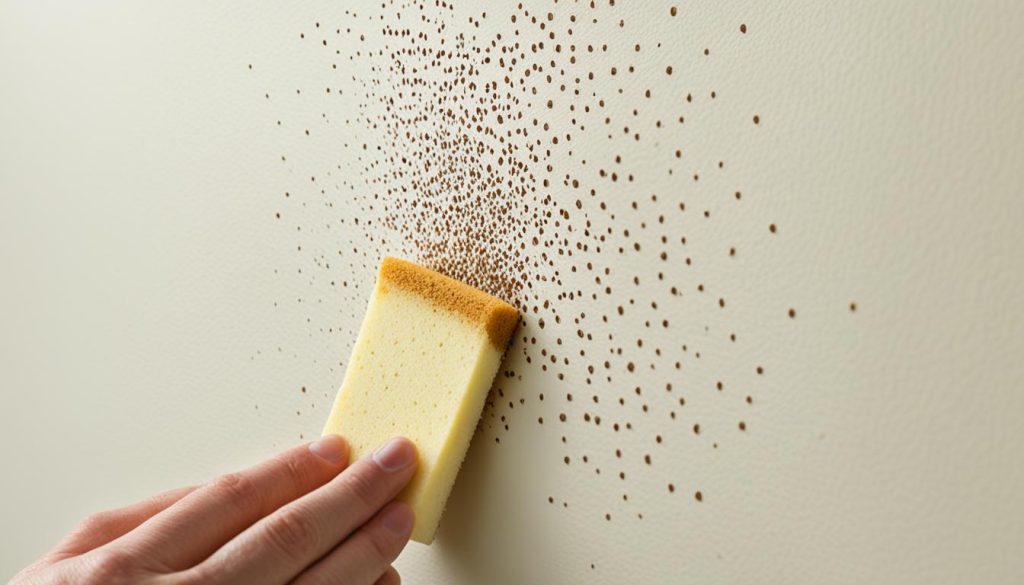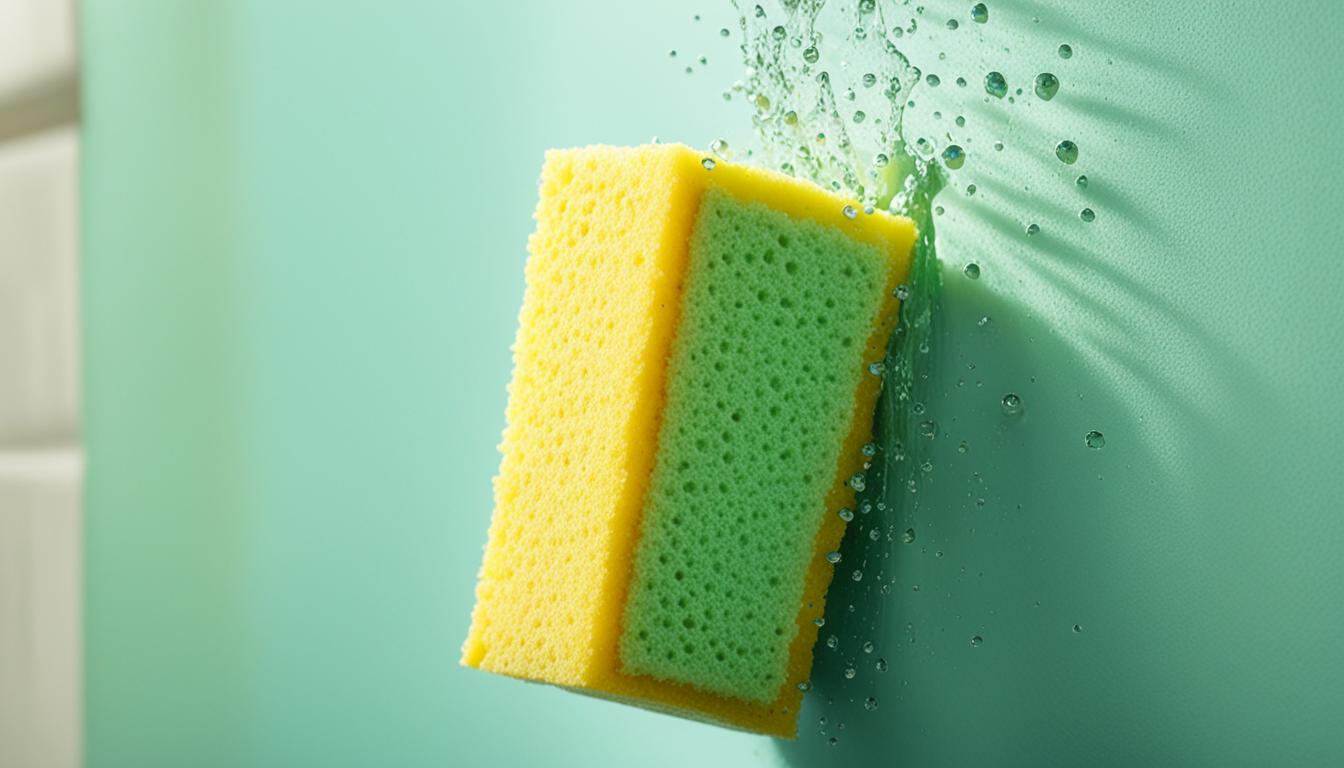If you think your walls are clean just because they look fine, think again. Did you know that the average home’s walls can accumulate up to 40 pounds of dust and dirt over a year? That’s right, those seemingly clean surfaces could be harboring hidden grime and allergens, affecting the overall cleanliness and air quality of your home.
But fret not, because in this easy guide, I will share with you the most effective tips and techniques to clean your walls like a pro. Whether you are dealing with painted walls, stubborn stains, or simply looking for the best wall cleaning products, I’ve got you covered. Say goodbye to dusty, dingy walls and hello to sparkling clean surfaces that will breathe new life into your home.
Key Takeaways:
- Regularly cleaning your walls is essential for maintaining a clean and healthy home environment.
- Differentiate the cleaning techniques and products based on whether you have painted walls or stained walls.
- Preventive measures and spot cleaning are effective ways to keep your walls stain-free.
- For mold and mildew issues, address the underlying cause and consider professional remediation if needed.
- Choose the right cleaning products and techniques to ensure the longevity of your walls and the paint finish.
Tips for Cleaning Painted Walls
Cleaning painted walls requires some special attention to ensure that you don’t damage the paint. Follow these tips to effectively clean your painted walls:
- Dust the walls: Start by dusting the walls using a vacuum or a microfiber duster. This will remove any loose dirt and debris.
- Prepare a cleaning solution: Mix a small amount of all-purpose cleaner or dishwashing liquid with warm water to create a cleaning solution. Alternatively, you can use a vinegar and water solution for a natural option.
- Apply the cleaning solution: Use a sponge or a microfiber cloth to apply the cleaning solution to the walls. Work in small sections from top to bottom, using gentle circular motions.
- Rinse the walls: After applying the cleaning solution, rinse the walls with a clean, damp cloth to remove any remaining soap residue.
- Remove stubborn stains: For stubborn stains, you can try using a paste made of baking soda and water or hydrogen peroxide. Apply the paste to the stain, let it sit for a few minutes, then gently scrub with a soft brush or sponge.
- Test cleaning products: It’s always a good idea to test any cleaning product on a small, inconspicuous area of the wall before proceeding to clean the entire surface. This will help ensure that the product doesn’t cause any damage or discoloration.
By following these wall cleaning techniques and using the right wall cleaning products, you can keep your painted walls looking clean and pristine.
Removing Stubborn Stains from Walls
Stubborn stains on walls can be a challenge to remove, but with the right techniques, you can get rid of them. Here are a few effective methods:
-
Baking soda and water paste: Baking soda is a natural stain fighter that can be used for various types of stains. Create a paste by mixing a half cup of baking soda with a quarter cup of water. Gently rub the paste onto the stained area of the wall, and the stain should lift.
-
Hydrogen peroxide for red wine stains: If you’re dealing with a red wine stain, dab a little hydrogen peroxide onto a cleaning rag and press it into the stain for five minutes. This should help remove the stain effectively.
-
Low-heat iron for grease stains: Grease stains on kitchen walls can be tricky to remove. Try placing a paper towel on top of the stain and using a low-heat iron to absorb the grease. The heat will help lift the stain without causing any damage to the wall.
For smaller stubborn stains, it’s always a good idea to keep a stain removal pen and a magic eraser on hand. These tools can quickly and easily remove minor stains, such as crayon markings or ballpoint ink.
Remember to test any cleaning product or method on a small, inconspicuous area of the wall before applying it to the entire stained surface. This will help you ensure that the cleaning product or method doesn’t cause any damage to the paint or wall material.
Now that you have some effective techniques for removing stubborn stains from walls, let’s move on to the next section where we’ll discuss how to choose the right wall cleaning products.

Comparison of Wall Cleaning Techniques
| Stain Type | Cleaning Technique |
|---|---|
| General stains | Baking soda and water paste |
| Red wine stains | Hydrogen peroxide |
| Grease stains | Low-heat iron with paper towel |
Choosing the Right Wall Cleaning Products
When it comes to cleaning walls, selecting the appropriate products is crucial for achieving optimal results. With a wide range of wall cleaning products available in the market, including all-purpose cleaners, vinegar-based solutions, and specialized wall cleaners, making the right choice can make a significant difference in the outcome. To ensure effective cleaning and minimize the risk of damage, it’s important to consider the type of paint finish on your walls and any specific cleaning instructions provided by the paint manufacturer.
For painted walls, it’s recommended to use mild, non-abrasive cleaners that are safe for the paint surface. All-purpose cleaners are versatile and can effectively remove everyday dirt and grime. Vinegar-based solutions, on the other hand, are known for their natural cleaning properties and can be particularly effective for grease and stains. If you have specific concerns or stains on your walls, there are specialized wall cleaners available that target different types of stains or surfaces.
Keep in mind that different wall cleaning products may have specific instructions for usage, so it’s important to follow them carefully to avoid any damage to your walls. Before using any product, test it on a small, inconspicuous area of the wall to ensure compatibility and to avoid any potential discoloration or damage.
Professional Wall Cleaning Services
If you prefer to leave the task of wall cleaning to the experts, professional wall cleaning services are available. These services specialize in providing thorough and efficient cleaning for all types of walls. By hiring professionals, you can ensure that your walls receive the care and attention they deserve, without the hassle of doing it yourself.
Professional wall cleaning services have the knowledge, experience, and equipment to handle a variety of wall cleaning needs. Whether you have large areas to clean or specific stains that require specialized products, professionals can deliver exceptional results, saving you time and effort.
Tips for Rinsing and Drying Walls
After cleaning the walls using the appropriate techniques discussed earlier, it is crucial to properly rinse off any cleaning solution and ensure that the walls are thoroughly dried. This step will help to remove any remaining soapy residue and prevent water stains or damage.
To rinse the walls, start by using a clean cloth soaked in clean water. Gently wipe the walls in a systematic manner, working from top to bottom, to ensure that all cleaning solution is removed. Take care not to use excessive water during this process.
Once the walls are rinsed, the next step is to dry them properly. There are several effective methods for drying walls, depending on the size of the walls and the environmental conditions.
If you prefer to dry the walls manually, use a clean and dry cloth or towel. Run the cloth over the surface of the walls to absorb any moisture and promote drying. Alternatively, you can open the windows in the room to facilitate air drying, allowing the natural airflow to expedite the drying process.
It is important to ensure that the walls are completely dry before replacing any wall hangings or furniture that usually sits closely to them. This will help to prevent any moisture-related issues, such as mold or mildew growth.
The time it takes for the walls to dry fully may vary depending on several factors, such as the size of the walls and the level of humidity in the environment. It is advisable to allow sufficient drying time to ensure optimal results.
Tips for Preventing and Spot Cleaning Wall Stains
To keep your walls looking clean and stain-free, it’s important to take preventive measures and spot clean any stains as soon as they appear. Here are some helpful tips:
- Avoid smoking indoors to prevent soot and smoke buildup on the walls.
- Teach children to keep their hands off the walls to prevent handprints and marks.
- Regularly dust the walls to remove dust and dirt buildup.
- Clean smudges and dirt around doorknobs and light switches.
When it comes to spot cleaning wall stains, here are some effective methods:
- Crayon markings: Use a baby wipe or a damp cloth with some mild soap to gently rub off the crayon marks.
- Ballpoint ink: Dab a non-gel toothpaste on the ink stain, gently scrub it with a cloth, and then wipe it clean with a damp cloth.
- Permanent marker: Rubbing alcohol can be effective in removing permanent marker stains. Apply a small amount of rubbing alcohol to a cloth and gently rub the stain until it lifts.
- Scuff marks: Foaming shaving cream can be surprisingly effective in removing scuff marks. Apply a small amount of shaving cream to a cloth or sponge, gently scrub the mark, and then wipe it away with a clean cloth.
By following these tips, you can maintain clean and stain-free walls in your home.

| Wall Stain Removal Methods | Effectiveness |
|---|---|
| Baby wipes | Highly effective for crayon markings and smudges |
| Non-gel toothpaste | Effective for ballpoint ink stains |
| Rubbing alcohol | Effective for permanent marker stains |
| Foaming shaving cream | Effective for scuff marks |
Dealing with Mold and Mildew on Walls
Mold and mildew can be a serious problem when it comes to the walls in your home. Not only are these growths unsightly, but they can also have detrimental effects on your health. That’s why it’s crucial to address mold and mildew issues promptly and effectively.
If you notice any signs of mold or mildew on your walls, it’s important to first identify and address the underlying cause. Leaks or high humidity levels can contribute to mold growth, so be sure to fix any leaks and implement proper moisture control measures. Once you’ve addressed the cause, you can proceed with cleaning the affected areas.
For small mold stains, you can try using a vinegar solution or an enzyme-based laundry cleaner. Simply dilute vinegar with water, apply it to the affected area, and scrub gently with a brush or sponge. Alternatively, you can use a commercial enzyme-based laundry cleaner, following the instructions provided by the manufacturer.
However, if the mold growth is extensive or persistent, it’s best to seek the assistance of a professional mold remediation service. These experts have the knowledge and equipment to effectively remove mold and ensure that it doesn’t reoccur. Additionally, they can help you identify and address any underlying issues that may have contributed to the mold growth.
To prevent mold and mildew growth in the first place, it’s essential to maintain proper ventilation and moisture control in your home. This includes using exhaust fans in bathrooms and kitchens, keeping windows open to promote air circulation, and using dehumidifiers in damp areas. Regularly inspecting your home for any signs of water leaks or excessive moisture and addressing them promptly can also go a long way in preventing mold on your walls.
